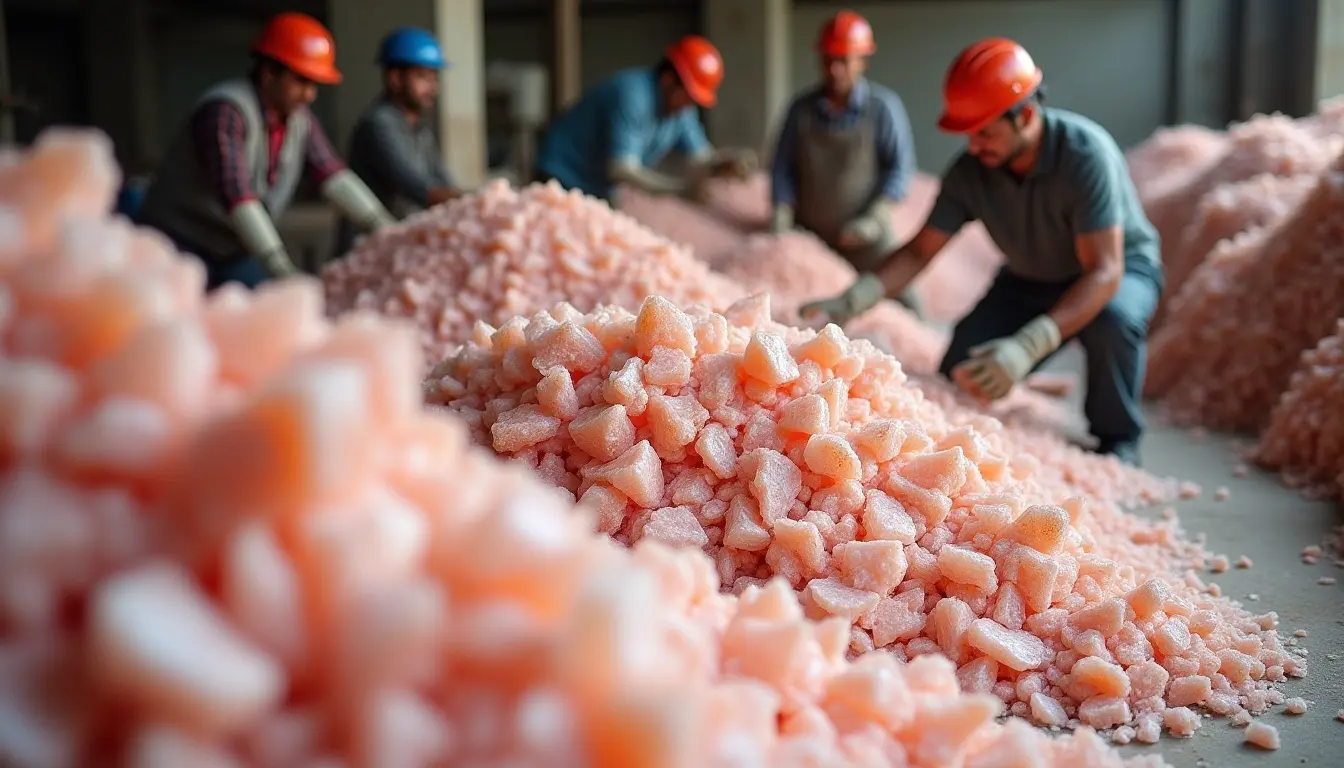Himalayan pink salt, with its high mineral content and beautiful pink colour, has become so popular all over the world not only because of its culinary use, but also because of its effectiveness in wellness purposes and beauty standards. However, just what does it take to transform this ancient crystal rock salt into the finished product that comes so proudly packaged and clean, ready to be found on the shelves in stores? In this article, we’ll walk you through the complete manufacturing process of Himalayan pink salt, from the extraction process at the source to the final packaging.
1. Sourcing from the Khewra Salt Mines
The journey begins deep within the Khewra Salt Mines, located in the Punjab region of Pakistan. These salt mines are among the oldest and largest salt reserves in the world, believed to be over 250 million years old. The pink salt is extracted from underground deposits formed by the evaporation of ancient sea beds.
Mining Methods:
Mining of the salt uses traditional room-and-pillar mining methods that are stable and safe. Workers manually extract huge tons of salt chunks through controlled dynamiting and drilling so as to avoid destroying the natural structure of the crystal.
2. Initial Sorting and Transport
Once the raw salt is extracted, it is transported to processing facilities. Here, it undergoes an initial visual inspection and sorting. The salt is graded based on:
- Color intensity
- Crystal size
- Purity level
Severe pieces tend to be stored away as decorative objects, such as pink salt lamps or animal licks, whereas medium-sized crystals are sent to edible and industrial processing.
3. Crushing and Grinding
Mechanical crushing is followed next. The salt rocks are crushed into smaller granules with the help of a series of crushers. The salt is ground into various sizes depending on what the final product will be used for:
- Fine salt powder
- Medium-sized grains (For cooking and bath soaks)
- Coarse grains (to use in grinders and finishing)
After this step, hygiene standards are observed quite strictly to allow food-grade safety.
4. Washing and Purification
The salt is then cleaned rigorously in the process of washing away any physical impurities or dust accumulation. This is necessary to give maximum cleanliness to this naturally antimicrobial material, despite its antimicrobial properties, and perhaps most importantly, to edible Himalayan rock salt.
The dried salt is then prepared by drying in big solar or mechanical dryers, ready to go into the next step.
5. Quality Control and Laboratory Testing
Every container of salt is taken to the laboratory to test:
- Percentage of purity (normally greater than 98 per cent sodium chloride)
- The presence of 84 minerals (such as calcium, potassium, magnesium, and iron)
- Moisture levels
- The lack of contamination (such as heavy metals)
ISO, HACCP, and FDA certifications are often required, especially for international exports.
6. Packaging and Private Labeling
After all the quality tests have been concluded, the Himalayan pink salt undergoes the packaging process; this can either be a manual or automated process.
There are the following typical packaging sizes:
- PET grinders and jars to place on the retail shelves
- Convenient pouches with or without zip locks
- Bulk Jumbo bags (25 or 50kg)
In the case of the international markets, it is also provided with customized private label packaging where the brands can reflect their identity. Regulatory information such as batch codes, country of origin, and traceability details is labelled on each package. Other common claims on marketing efforts include 100% natural, hand-mined, among others, which are meant to attract health-conscious consumers.
Ready to source authentic Himalayan pink salt for your brand?
Partner with Ittefaq Salt – a bulk Himalayan salt manufacturer to get premium quality Himalayan pink salt, flexible private label solutions, and worldwide distribution you can trust.
7. Global Distribution
The Himalayan pink salt, after packaging, is stored in the temperature-controlled warehouses to ensure its quality. It is then sent out either by land, by sea, or by air, depending on where it is going. As a result of its production, salt is sold in the worldwide market to wholesalers, retailers, and manufacturers. The most significant export destinations involve the USA, Europe, the Middle East, Africa, and Asia.
Concluding Remarks:
The process of Himalayan pink salt production is an interesting combination of traditional harvesting methods and the current expectations related to the quality of this product.
From the historic mines of Khewra to your kitchen or spa, every crystal undergoes a carefully inspected process to retain its natural purity and health benefits.
Himalayan pink salt is as remarkable as its path to the market because, despite the rising popularity of natural products among consumers, this type of salt is becoming increasingly popular, as it is the symbol of quality and authenticity.
Also Read-What ITIL Certification Reveals About Business Maturity

